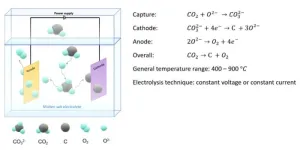(Press-News.org) Cambridge scientists have set out principles for how computational science – which powers discoveries from unveiling the mysteries of the universe to developing treatments to fight cancer to improving our understanding of the human genome, but can have a substantial carbon footprint – can be made more environmentally sustainable.
Writing in Nature Computational Science, researchers from the Department of Public Health and Primary Care at the University of Cambridge argue that the scientific community needs to act now if it is to prevent a potentially uncontrolled rise in the carbon footprint of computational science as data science and algorithms increase in usage.
Dr Loïc Lannelongue, who is a research associate in biomedical data science and a postdoctoral associate at Jesus College, Cambridge, said: “Science has transformed our understanding of the world around us and has led to great benefits to society. But this has come with a not-insignificant – and not always well understood – impact on the environment. As scientists – as with people working in every sector – it’s important that we do what we can to reduce the carbon footprint of our work to ensure that the benefits of our discoveries are not outweighed by their environmental costs.”
Recent studies have begun to explore the environmental impacts of scientific research, with an initial focus on scientific conferences and experimental laboratories. For example, the 2019 Fall Meeting of the American Geophysical Union was estimated to emit 80,000 tons of CO2e* (tCO2e), equivalent to the average weekly emissions of the city of Edinburgh, UK. The annual carbon footprint of a typical life science laboratory has been estimated to be around 20 tCO2e.
But there is one aspect of research that often gets overlooked – and which can have a substantial environmental impact: high performance and cloud computing.
In 2020, the Information and Communication Technologies sector was estimated to have made up between 1.8% and 2.8% of global greenhouse gas emissions – more than aviation (1.9%). In addition to the environmental effects of electricity usage, manufacturing and disposal of hardware, there are also concerns around data centres’ water usage and land footprint.
Professor Michael Inouye said: “While the environmental impact of experimental ‘wet’ labs is more immediately obvious, the impact of algorithms is less clear and often underestimated. While new hardware, lower-energy data centres and more efficient high performance computing systems can help reduce their impact, the increasing ubiquity of artificial intelligence and data science more generally means their carbon footprint could grow exponentially in coming years if we don’t act now.”
To help address this issue, the team has developed GREENER (Governance, Responsibility, Estimation, Energy and embodied impacts, New collaborations, Education and Research), a set of principles to allow the computational science community to lead the way in sustainable research practices, maximising computational science’s benefit to both humanity and the environment.
Governance and Responsibility – Everyone involved in computational science has a role to play in making the field more sustainable: individual and institutional responsibility is a necessary step to ensure transparency and reduction of greenhouse gas emission.
For example, institutions themselves can be key to managing and expanding centralised data infrastructures, and in ensuring that procurement decisions take into account both the manufacturing and operational footprint of hardware purchases. IT teams in high performance computing (HPC) centres can play a key role, both in terms of training and helping scientists monitor the carbon footprint of their work. Principal Investigators can encourage their teams to think about this issue and give access to suitable training. Funding bodies can influence researchers by requiring estimates of carbon footprints to be included in funding applications.
Estimate and report the energy consumption of algorithms – Estimating and monitoring the carbon footprint of computations identifies inefficiencies and opportunities for improvement.
User-level metrics are crucial to understanding environmental impacts and promoting personal responsibility. The financial cost of running computations is often negligible, particularly in academia, and scientists may have the impression of unlimited and inconsequential computing capacity. Quantifying the carbon footprint of individual projects helps raise awareness of the true costs of research.
Tackling Energy and embodied impacts through New collaborations – Minimising carbon intensity – that is, the carbon footprint of producing electricity – is one of the most immediately impactful ways to reduce greenhouse gas emissions. This could involve relocating computations to low-carbon settings and countries, but this needs to be done with equity in mind. Carbon intensities can differ by as much as three orders of magnitude between the top and bottom performing high-income countries (from 0.10 gCO2e/kWh in Iceland to 770 gCO2e/kWh in Australia).
The footprint of user devices is also a factor: one estimate found that almost three-quarters (72%) of the energy footprint of streaming a video to a laptop is from the laptop, with 23% used in transmission and a mere 5% at the data centre.
Another key consideration is data storage. The carbon footprint of storing data depends on numerous factors, but the life cycle footprint of storing one terabyte of data for a year is of the order of 10 kg CO2e. This issue is exacerbated by the duplication of such datasets in order for each institution, and sometimes each research group, to have a copy. Large (hyperscale) data centres are expected to be more energy efficient, but they may also encourage unnecessary increases in the scale of computing (the ‘rebound effect’).
Education and Research – Education is essential to raise awareness of the issues with different stakeholders. Integrating sustainability into computational training courses is a tangible first step toward reducing carbon footprints. Investing in research that will catalyse innovation in the field of environmentally sustainable computational science is a crucial role for funders and institutions to play.
Recent studies found that the most widely-used programming languages in research, such as R and Python, tend to be the least energy efficient ones, highlighting the importance of having trained Research Software Engineers within research groups to ensure that the algorithms used are efficiently implemented. There is also scope to use current tools more efficiently by better understanding and monitoring how coding choices impact carbon footprints.
Dr Lannelongue said: “Computational scientists have a real opportunity to lead the way in sustainability, but this is going to involve a change in our culture and the ways we work. There will need to more transparency, more awareness, better training and resources, and improved policies.
“Cooperation, open science, and equitable access to low-carbon computing facilities will also be crucial. We need to make sure that sustainable solutions work for everyone, as they frequently have the least benefit for populations, often in low- and middle-income countries, who suffer the most from climate change.”
Professor Inouye added: “Everyone in the field – from funders to journals to institutions down to individuals – plays an important role and can, themselves, make a positive impact. We have an immense opportunity to make a change, but the clock is ticking.”
The research was a collaboration with major stakeholders including Health Data Research UK, EMBL-EBI, Wellcome and UK Research and Innovation (UKRI).
*CO2e, or CO2-equivalent, summarises the global warming impacts of a range of greenhouse gases and is the standard metric for carbon footprints, although its accuracy is sometimes debated.
Reference
Lannelongue, L et al. GREENER principles for environmentally sustainable computational science. Nat Comp Sci; 26 June; DOI: 10.1038/s43588-023-00461-y
END
Act now to prevent uncontrolled rise in carbon footprint of computational science, say Cambridge scientists
2023-06-26
ELSE PRESS RELEASES FROM THIS DATE:
Study of Earth’s stratosphere reduces uncertainty in future climate change
2023-06-26
New research led by the University of East Anglia (UEA) reduces uncertainty in future climate change linked to the stratosphere, with important implications for life on Earth.
Man-made climate change is one of the greatest challenges facing us today, but uncertainty in the exact magnitude of global change hampers effective policy responses.
A significant source of uncertainty relates to future changes to water vapour in the stratosphere, an extremely dry region of the atmosphere 15–50 km above the Earth’s surface.
Future increases in water vapour here risk amplifying climate change and slowing down the recovery ...
New study reveals brain's potential to regulate fentanyl consumption, offering hope in the fight against opioid addiction
2023-06-26
The opioid crisis continues to pose a grave public health concern, with synthetic opioids such as fentanyl posing a major risk for development of addiction and death due to overdose. In a ground-breaking development, a recent study by the research group led by Prof. Ami Citri at the Hebrew University of Jerusalem's Edmond and Lily Safra Center for Brain Sciences has unveiled crucial insights into the brain's potential ability to regulate the urge to consume fentanyl. This discovery offers a glimmer of hope in the ongoing battle against ...
Supplemental Nutrition Assistance Program access and racial disparities in food insecurity
2023-06-26
About The Study: Racial disparities in food insecurity were found among low-income households that do not participate in Supplemental Nutrition Assistance Program (SNAP) but not among those that do, suggesting that access to SNAP should be improved. These results also highlight the need to examine the structural and systemic racism in food systems and in access to food assistance that may contribute to disparities.
Authors: Laura J. Samuel, Ph.D., R.N., of the Johns Hopkins School of Nursing in Baltimore, is the corresponding author.
To access the embargoed study: Visit our For The Media website at this link https://media.jamanetwork.com/
(doi:10.1001/jamanetworkopen.2023.20196)
Editor’s ...
Study of deep-sea corals reveals ocean currents have not fuelled rise in atmospheric carbon dioxide
2023-06-26
Pioneering analysis of deep-sea corals has overturned the idea that ocean currents contributed to increasing global levels of carbon dioxide in the air over the past 11,000 years.
The study, led by the University of Bristol in the UK and Nanjing University in China, examined historic deep-sea corals to shed intriguing new light on the history of ocean chemistry.
Understanding what has led to the pre-industrial rise in carbon dioxide (CO2) levels during the Holocene period, which dates back some 11,700 years to the present day, is a source of scientific debate. One theory suggests the increase in physical ...
Tuning T cell traits and functions with biomechanical materials
2023-06-26
By Benjamin Boettner
(Boston) — The successful campaign of adoptive T cell therapies, a type of immunotherapy in which immune T cells are collected from a patient, enhanced outside of the body, and reinfused back into the same patient, especially against blood cancers is well under way. But improving the ability to create patient-specific T cell populations with specific traits and functions could broaden clinicians’ repertoire of T cell therapies.
One way to approach this goal is to better understand how T cells’ traits and functions, including their cytotoxic effects on ...
New understanding of why kidney cancers become metastatic discovered by MD Anderson researchers
2023-06-26
HOUSTON ― Researchers at The University of Texas MD Anderson Cancer have engineered a new model of aggressive renal cell carcinoma (RCC), highlighting molecular targets and genomic events that trigger chromosomal instability and drive metastatic progression.
The study, published today in Nature Cancer, demonstrates that the loss of a cluster of interferon receptor (IFNR) genes plays a pivotal role in allowing cancer cells to become tolerant of chromosomal instability. This genomic feature may be used to help clinicians predict a tumor’s potential to become metastatic and treatment resistant.
Researchers led by Luigi Perelli, ...
Dry days trigger leaves to send a surprising growth signal telling roots to keep growing
2023-06-26
Scientists at the Sainsbury Laboratory Cambridge University (SLCU) have discovered a new molecular signalling pathway, triggered when leaves are exposed to low humidity, that ensures plant roots keep growing towards water.
In dry soil conditions, plants take action to try and conserve water by producing the drought stress hormone abscisic acid (ABA). For decades plant scientists thought that in response to dry soil, ABA was made in the roots and then transported to the leaves. In this root-to-shoot signalling pathway, ABA closes microscopic leaf pores, called stomata, to prevent water loss from leaves. In recent years, scientists ...
Study on rare antibodies hints at strategy tweaks that may future-proof COVID-19 vaccines
2023-06-26
New research examining how frequently our bodies produce broadly neutralizing antibodies (bnAbs) capable of thwarting a range of SARS-CoV-2 variants offers clues on the strategy tweaks that could potentially future-proof COVID-19 vaccines.
To counter invading viruses, our body deploys specific antibodies, among them the neutralizing kind targeting the receptor-binding domain (RBD) — the “Velcro hooks” used by pathogens to fasten onto our cells. As SARS-CoV-2 accumulates genetic mutations, new variants emerge donning sneaky disguises to outsmart our defenses. So-called bnAbs are elite neutralizing antibodies that can keep up ...
Overview of CO2 capture and electrolysis technology in molten salts: operational parameters and their effects
2023-06-26
Carbon dioxide capture, storage, and utilization have been widely researched to achieve CO2 zero emission and resolve climate change issues. Molten salt electrolysis is one promising method to simultaneously capture and convert CO2 into valuable carbon materials and oxygen with high current efficiencies, to provide a promisingly positive cash flow. However, this method still requires investigation for future scale-up applications. A team of scientists reviews the molten salt CO2 electrolysis’s ...
Researchers urge caution in gene editing early human embryos following findings that it could have unexpected and dangerous consequences Further research to refine gene editing technology is needed
2023-06-26
Copenhagen, Denmark: Scientists have discovered that the cells of early human embryos are often unable to repair damage to their DNA. The researchers say that this has important implications for the proposed use of gene editing techniques to remove serious inherited diseases from embryos, as well as for IVF in general.
Presenting the research to the 39th annual meeting of the European Society of Human Reproduction and Embryology (ESHRE) [1], Dr Nada Kubikova from the University of Oxford (UK), said: “Gene editing has the potential to correct defective genes, a process that usually involves first breaking and then ...



